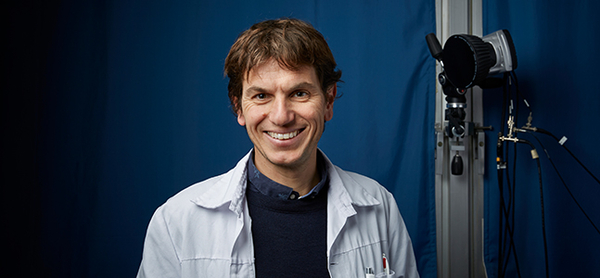A simulator for better surgery

Cerebral palsy impairs children’s ability to walk. Choosing the right treatment can be a challenge. Stéphane Armand is developing a simulator which doctors can use to test different surgical procedures.
Medical imaging is basically static. Our research aims to make it more dynamic. Armand’s specialist field is the study of walking. Most people simply take walking for granted, but if you are affected by cerebral palsy, nothing is simple. Every year, approximately 200 children in Switzerland are diagnosed with the disease. “There are numerous motor systems and they cover a broad spectrum,” says Armand, a biomechanist at the University of Geneva. “Some children walk on tiptoe, with knees bent and hips turned inwards. The precise reasons for this are very hard to discern. We hope that our research will lead to better diagnoses and help doctors choose the best treatment.”
Modelling gaits
With this aim in mind, Stéphane Armand started developing an online gait simulator together with a biorobotics team at EPF Lausanne and an AI team from Haute école de gestion de Genève (HEG). His work is funded under the SNSF’s Sinergia programme, which promotes interdisciplinary projects. In the future, doctors should be able to enter information about their patients’ impaired mobility, simulate the effects of different operations and choose the most suitable intervention.
To develop the simulator, the researchers need data from children affected by the disease. Armand conducts his gait analyses in a corridor of the orthopaedic wing of Geneva University Hospital. Optoelectronic cameras record the patients as they walk and digitalise all their movements. Small circles attached to the skin reflect infrared light and facilitate a permanent and precise positioning – a technique also used by creators of special effects in films. Sensors at the muscles measure the electrical currents that indicate muscular activity. At the same time, a platform records how the patients’ feet touch the ground while walking.
Need for large datasets
All of these data are combined to generate a profile of the patients’ impairments. “We want to better understand how musculoskeletal problems affect walking and at the same time make it possible to diagnose motor deficits based on our measurements,” says Stéphane Armand.
He is working with hospitals abroad to collect more data. A large volume of data is crucial for machine learning, a method of artificial intelligence. Creating reliable links between lab measurements and impaired movement is otherwise impossible. With this work, the Geneva research group is setting new standards that will enhance the analysis of impaired movement across the board.